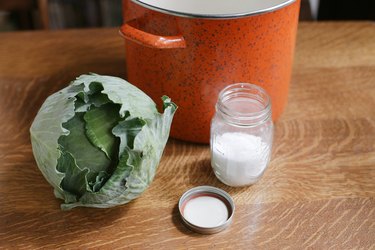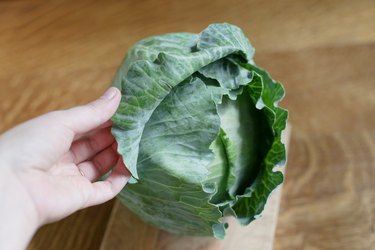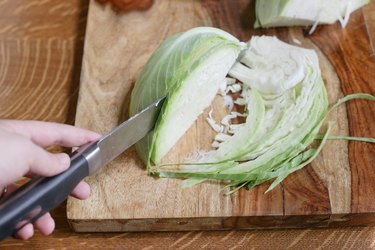
Whether you want to top a bratwurst or make authentic sour cabbage rolls, making your own soured cabbage provides an option beyond jarred sauerkraut. Soured cabbage requires fermentation, called lacto-fermentation, which takes advantage of the naturally occurring Lactobacillus bacteria on cabbage to create the sour, crunchy treat. The process can take weeks, but the actual hands-on time is minimal.
Ingredients and Tools
Video of the Day

Any large, food-safe container works well for making sour cabbage. A pickling or sauerkraut crock, usually made of glass or clay, provides the best option, but wooden crocks or plastic buckets also work well. The crock must be large enough so the cabbage is fully submerged during the fermenting process. The only other necessary item is salt. Any non-iodized salt works well, but canning or pickling salt is recommended because it doesn't contain iodine or anti-caking agents. Other seasonings can be used along with the salt, depending on your recipe and preferences.
Video of the Day
Soured Cabbage Heads

Souring whole cabbage heads for traditional Croatian sauerkraut, called kiseli kupus, begins with the removal of the bruised outer leaves from a firm head of cabbage. After trimming, cut out the core with a sharp knife and fill the cavity inside the head with the salt. The filled cabbage is placed in the bucket or crock with the core facing up. If you prefer to add additional seasonings, such as garlic, horseradish, peppers, or herbs such as bay, layer these on top the cabbage head. You can stack several heads of cabbage in a single container. Fill the container with water to cover the cabbage, placing a piece of cheesecloth over the top head and laying a plate, clean rock, or a plastic bag filled with salt water on top to keep the cabbages submerged.
Shredded Sauerkraut

The more common shredded sauerkraut requires first washing and coring the cabbages, and then shredding them so no piece is thicker than 1/8- to 1/4-inch. The shredded cabbage is mixed with salt, at the rate of about 3 tablespoons salt to every 5 pounds of shredded cabbage. Packing the cabbage into the jar firmly allows the salt to begin drawing the juices from the cabbage. Once the crock is filled, the liquid leeched from the cabbage leaves should cover the cabbage. Place a plate and weight on top to keep the cabbage submerged in the brine.
Fermentation

Soured cabbage ferments in temperatures between 60 and 75 degrees Fahrenheit. Generally, the cabbage is ready within four weeks when temperatures remain between 70 and 75 degrees, but it may take up to six weeks at the lower end of the recommended temperature range. If scum appears on the surface of the brine during fermenting, skim it off with a sterile spoon. Properly fermented sour cabbage is crunchy in a clear brine. Dispose of the cabbage if the brine is cloudy, there is a foul odor, or if it shows signs of slime or mold growth.